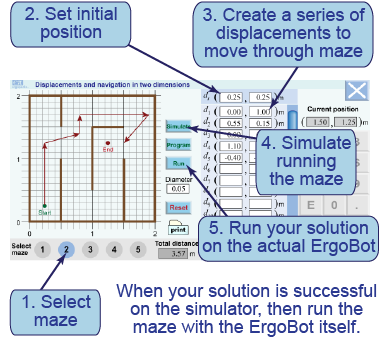|
| Essential questions | | How is robot motion programmed? | |
|
Vectors are the fundamental way in which robotic technology operates. Each motion of a robot is described by displacement, velocity, and acceleration vectors. In this investigation you will solve different navigation challenges using two-dimensional vectors to solve a series of mazes. 
|
Part 1: Simulating the ErgoBot navigating a maze
 To solve the challenge, find a series of vectors that move from the green circle (start) to the red circle (finish) without crossing any of the walls of each maze. You may make up to 20 displacements.
To solve the challenge, find a series of vectors that move from the green circle (start) to the red circle (finish) without crossing any of the walls of each maze. You may make up to 20 displacements. - Choose the first maze and try to solve it on the screen with as few vectors as possible.
- Choose the second maze. Work out a solution. Your instructor will lay out a real maze on the floor with tape.
- What is the minimum number of vectors that can solve each of the four mazes?
- What is the minimum total distance you can achieve that solves each of the four mazes?
- Maze 4 has a circular path. Do you think more than 20 vectors would allow you to find a solution with a shorter distance? Why or why not? Estimate with your group how much shorter you believe you could get. Could you find a course that is 10% shorter with an unlimited number of vectors? How about 20% shorter?
- What changes must you make so that the actual ErgoBot can navigate a real maze rather than the theoretical maze on the screen?
- Discuss the accuracy and precision of the ErgoBot’s motion and how this might affect programming it to successfully solve the maze without hitting a wall.

|
|
In this interactive simulation, you will use a series of two-dimensional displacements in order to navigate through a series of mazes. Once you have a solution for each maze, you can upload the displacement commands to the ErgoBot and have it run the same maze on the floor of your classroom.
|
Part 2: Force, inertia, and a race course

- In this interactive simulation, two players race through a course to the finish line.
- During their turns, players may apply a force of 1 N in any direction (or choose zero force instead).
- Using the setup button, you may choose a different race course or switch to one-player mode.
- How does an upward applied force change the velocity of the cart?
- Are there negative forces applied in this activity? Explain.
- Explain the role of inertia in this activity.

|
|
In this interactive simulation you can compete against another student to complete a race course. In each turn, you can apply a one newton force in any of the cardinal directions—or zero force. Watch that you don’t start moving too fast, or you might not be able to turn fast enough to avoid hitting the wall!
|

